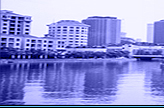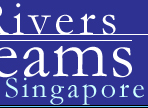



|
Water Supply and the River Systems In the past three decades, the water supply system had been extensively expanded to support Singapore's rapid economic developments and the attendant increase in water demand. In 1999, the population of Singapore was 3.9 million and daily water consumption was 1.3 million cubic metres. Currently, Singapore uses 1.4 million cubic metres water a day, and this is expected to increase by a third in 10 years' time. Singapore’s water supply system comprises of raw water reservoirs, water treatment works, storage or service reservoirs and an extensive network of pipelines. However, this is insufficient and water has to be purchased from Malaysia and Indonesia. New sources of water supply include water reclamation (NEWater) and seawater desalination. Singapore’s first large-scale desalination plant, capable of desalinating about 140,000 cubic metres of seawater daily, would be operational by 2005. The rivers in Singapore have important functions of collecting and transporting water. The primary sources of water supply in Singapore are impounding reservoirs. In 1867, the first reservoir, the Thomson Reservoir (MacRitchie Reservoir) was built. Currently there are 14 impounding reservoirs in Singapore. The reservoirs are generally shallow, with depths ranging from 10 to 25 m. The total holding capacity of all these reservoirs amounts to approximately 140 million cubic metres of water. There are 6 main areas that are designated as water catchment areas to channel water to these reservoirs. They extend over half of Singapore’s land, and URA has established Development Guide Plans (DGPs) for these water catchment planning areas.. There are regulations (PUB Act,1972) to ensure that these primary water sources will not become polluted. The main sources of water pollution in Singapore are domestic wastewater, both sewage and sullage, and industrial effluent. In addition, solid wastes or rubbish, if not properly managed and disposed of, will also cause water pollution. Domestic wastewater contains mainly organic pollutants, both suspended and dissolved. Industrial effluent contains chemical and organic pollutants. In Singapore, strict control measures have been undertaken to minimize the effects of pollution of the raw water within the catchment area and impounding reservoirs. On 1 April 1999, the Environmental Pollution Control Act (EPCA) was enacted. This Act consolidates the previous separate laws on air, water and noise pollution and hazardous substances control. In addition, the National Environment Agency (NEA) regularly monitors the water quality of various inland water bodies and coastal areas. The inland waterbodies comprise streams in the catchment areas, where water is collected for the production of drinking water, and in non-water catchment areas. Physical, chemical and biological parameters are analyzed to assess the water quality. Massive projects have been undertaken to clean up
polluted rivers in Singapore. The cleaning-up of the Singapore River
and Kallang Basin was a major effort in the environmental restoration
of a river. By October 1977, plans were put up and actions were
taken to clean up the Singapore River and Kallang Basin (Plate V).
The project, which was started in 1977, took ten years to complete.
By 1987, the river, which was once heavily polluted, was transformed
to one where aquatic life is thriving. |
|||||
| Developed by Centre For Instructional Technology, NUS © 2003 | ||||||
![]]] CASE STUDY [[[](images/but_csstd_up.jpg)
